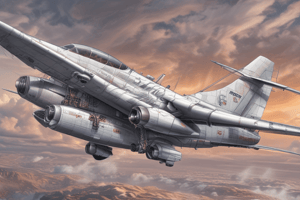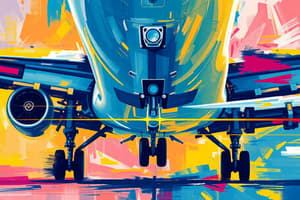Podcast
Questions and Answers
What did the Wright brothers achieve in 1903 that was a landmark in aviation?
What did the Wright brothers achieve in 1903 that was a landmark in aviation?
- The first flight using hot air balloons
- The first powered and controlled flight (correct)
- The first flight across the Atlantic Ocean
- The first flight in outer space
What was the innovative design feature of the Wright Flyer?
What was the innovative design feature of the Wright Flyer?
- Fixed-wing configuration with a gasoline engine (correct)
- Helicopter-like rotor blades
- No wings, just a balloon structure
- Flapping wings like a bird
How did the Wright brothers' aircraft differ from previous attempts at flying machines?
How did the Wright brothers' aircraft differ from previous attempts at flying machines?
- Mimicked the flapping of bird wings
- Utilized fixed wings and a gasoline engine (correct)
- Had no surface area for lift
- Used hot air balloons for lift
What was the common belief that the Wright brothers' design contradicted?
What was the common belief that the Wright brothers' design contradicted?
How did the Wright brothers' expertise in mechanics and aerodynamics contribute to their success?
How did the Wright brothers' expertise in mechanics and aerodynamics contribute to their success?
Why was the Wright Flyer considered a radical departure from previous attempts at flight?
Why was the Wright Flyer considered a radical departure from previous attempts at flight?
What key benefit do composite materials provide in modern aviation technology?
What key benefit do composite materials provide in modern aviation technology?
Which technology is known for computer-controlled flight systems in modern aircraft?
Which technology is known for computer-controlled flight systems in modern aircraft?
What was significant about the McDonnell Douglas MD-11 in modern aviation history?
What was significant about the McDonnell Douglas MD-11 in modern aviation history?
Which aircraft made a groundbreaking achievement by completing the first non-stop solo flight across the Atlantic Ocean?
Which aircraft made a groundbreaking achievement by completing the first non-stop solo flight across the Atlantic Ocean?
What is the primary focus of modern aviation technology's evolution?
What is the primary focus of modern aviation technology's evolution?
Which aircraft marked a new era of long-haul passenger travel with its first flight?
Which aircraft marked a new era of long-haul passenger travel with its first flight?
Flashcards are hidden until you start studying
Study Notes
The First Flight: A Pivotal Moment in Modern Aviation Technology
On a sunny December day in 1903, two brothers from North Carolina, Orville and Wilbur Wright, set history in motion. Their landmark achievement – the first powered, controlled, and sustained heavier-than-air aircraft flight – marked the dawn of a new era in transportation and technology. This article will explore the significance of that first flight, its impact on modern aviation technology, and the milestones that followed.
The Wright Brothers and Their Innovative Approach
The Wright brothers, engineers by training, were fascinated by the concept of human flight. They studied previous attempts and theories, drawing upon their knowledge of mechanics and aerodynamics. The brothers' innovative approach to design and experimentation proved crucial, as they created a wingspan and lifting-surface configuration that countered the common belief that a heavier-than-air aircraft would require a vast expanse of surface area to fly.
The Wright brothers' fixed-wing aircraft, equipped with a gasoline engine that drove two propellers, was a radical departure from previous attempts, which typically involved attempts to mimic the flapping of bird wings. Their aircraft, the Wright Flyer, captured the imagination of the world and set the stage for the rapid development of aviation technology.
The First Flight: Achieving the Impossible
On December 17, 1903, Orville Wright took to the air, piloting the Wright Flyer for a successful 12-second flight. The following day, Wilbur Wright took his turn at the controls, flying the aircraft for 59 seconds. These milestone flights were continued with a series of increasingly longer flights, each pushing the boundaries of human achievement and aviation technology.
The first flight not only demonstrated that flight was possible but also laid the groundwork for countless innovations in aviation technology. The Wright brothers' aircraft was just the beginning of a long history of progress and advancements, which continue to shape the world of aviation to this day.
The Evolution of Flight: From the Wright Brothers to Modern Aviation
Following the Wright brothers' pioneering achievement, the aviation industry grew rapidly, with numerous innovations and advancements. Some key milestones in aviation history include:
- 1910: The first airline, Deutsche Luft-Reederei, was established in Germany.
- 1914: The first passenger airline services were introduced in the United States.
- 1927: Charles Lindbergh successfully completed the first non-stop solo flight across the Atlantic Ocean.
- 1947: The first jet-powered airliner, the de Havilland Comet, made its maiden flight.
- 1958: The Boeing 707 became the first wide-body commercial airliner, revolutionizing international air travel.
- 1969: The Boeing 747, known as the Jumbo Jet, made its first flight, offering a new era of long-haul passenger travel.
- 1976: The first successful flight of a supersonic airliner, the Concorde, demonstrated the potential for faster-than-sound travel.
- 1981: The McDonnell Douglas MD-11, the world's first fly-by-wire airliner, made its first flight.
- 2005: The Airbus A380, the world's largest passenger airliner, made its first flight.
- 2021: The first successful test flight of SpaceX's Starship, with the potential to revolutionize space exploration and transportation.
These milestones, and many others, have pushed the boundaries of aviation technology, making the once unimaginable a reality.
Modern Aviation Technology
Today, aviation technology continues to evolve, with a focus on increased efficiency, safety, and sustainability. Some modern aviation technologies include:
- Composite materials: Strong and lightweight materials, such as carbon fiber, used to build aircraft, reducing weight and improving fuel efficiency.
- Fly-by-wire technology: Computer-controlled flight systems that help improve safety and handling.
- Advanced engines: New jet engines provide increased fuel efficiency and reduced emissions.
- Electric and hybrid-electric aircraft: Emerging technologies that can reduce noise pollution and emissions.
- Autonomous flight: Innovative systems that enable aircraft to fly autonomously, reducing human error and improving safety.
- Urban air mobility: The development of electric vertical takeoff and landing (eVTOL) aircraft that could revolutionize urban transportation.
- Advanced communications and navigation systems: Enhanced technology for air traffic control, aircraft communication, and navigation.
These modern aviation technologies are pushing the boundaries of what is possible, creating a more sustainable, efficient, and safe future for aviation.
In conclusion, the first flight by the Wright brothers marked a pivotal moment in human history, laying the groundwork for the rapid development of aviation technology. As we continue to make advancements, the future of aviation promises to be even more exciting and transformative. The next great leap in aviation technology is just around the corner, and it's an exciting time to be a part of this amazing industry.
Studying That Suits You
Use AI to generate personalized quizzes and flashcards to suit your learning preferences.




